THE LIVING WORLD
Unit Seven. Plant Life
32. Evolution of Plants
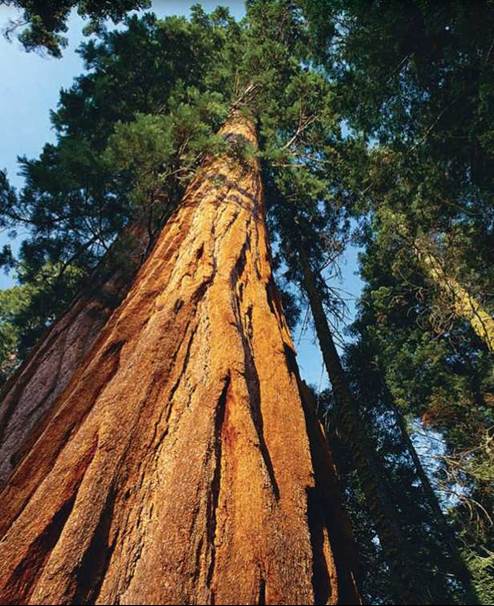
Plants are thought to be descendants of green algae. Plants first invaded the land over 455 million years ago in partnership with fungi—the most ancient surviving plants have mycorrhizal associations. One of the many challenges posed by the terrestrial environment was the difficulty of finding a mate when anchored to one spot. The solution adopted by most early plants was for male individuals to cast their gametes—pollen—into the wind, and let air currents carry pollen grains to nearby female plants. This strategy works particularly well in dense stands, in which there are many nearby individuals of the same species. The massive redwood tree seen here, one of the largest individual organisms living on land, grows in dense stands and is wind pollinated. An alternative solution proved even better, however. Plants evolved flowers, devices to attract insects. When insects visit the flower to obtain nectar, they become coated with pollen. When they then visit another flower seeking more nectar, they deposit some of this pollen, pollinating that flower. It doesn’t matter how far apart the two plants are from each other—the insect will seek them out. In this chapter, you will explore this and other evolutionary challenges met by plants as they colonized the land.
32.1. Adapting to Terrestrial Living
Plants are complex multicellular organisms that are terrestrial autotrophs—that is, they occur almost exclusively on land and feed themselves by photosynthesis. The name autotroph comes from the Greek, autos, self, and trophos, feeder. Today, plants are the dominant organisms on the surface of the earth (figure 32.1). Nearly 300,000 species are now in existence, covering almost every part of the terrestrial landscape. In this chapter, we see how plants adapted to life on land.
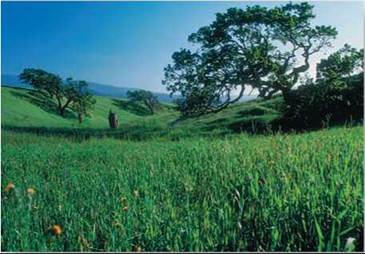
Figure 32.1. Plants dominate life on land.
Plants are astonishingly diverse and are key components in the biosphere. For example, photosynthesis conducted by plants creates oxygen in the atmosphere, plants are the main source of food for humans and many other organisms (directly and indirectly), and plants provide us with wood, cloth, paper, and many other nonfood products.
The green algae that were probably the ancestors of today’s plants are aquatic organisms that are not well adapted to living on land. Before their descendants could live on land, they had to overcome many environmental challenges. For example, they had to absorb minerals from the rocky surface. They had to find a means of conserving water. They had to develop a way to reproduce on land.
Absorbing Minerals
Plants require relatively large amounts of six inorganic minerals: nitrogen, potassium, calcium, phosphorus, magnesium, and sulfur. Each of these minerals constitutes 1% or more of a plant’s dry weight. Algae absorb these minerals from water, but where is a plant on land to get them? From the soil. Soil is the weathered outer layer of the earth’s crust. It is composed of a mixture of ingredients, which may include sand, rocks, clay, silt, humus (partly decayed organic material), and various other forms of mineral and organic matter. The soil is also rich in microorganisms that break down and recycle organic debris. Plants absorb these materials, along with water, through their roots (described in chapter 33). Most roots are found in topsoil, which is a mixture of mineral particles, living organisms, and humus. When topsoil is lost due to erosion, the soil loses its ability to hold water and nutrients.
The first plants seem to have developed a special relationship with fungi, which was a key factor in their ability to absorb minerals in terrestrial habitats. Within the roots or underground stems of many early fossil plants like Cooksonia (see figure 32.6) and Rhynia, fungi can be seen living intimately within and among the plant’s cells. As you may recall from chapter 18, these kinds of symbiotic associations are called mycorrhizae.
In plants with mycorrhizae, the fungi enable the plant to take up phosphorus and other nutrients from rocky soil, while the plant supplies organic molecules to the fungus.
Conserving Water
One of the key challenges to living on land is to avoid drying out. To solve this problem, plants have a watertight outer covering called a cuticle. The covering is formed from a waxy substance that is impermeable to water. Like the wax on a shiny car, the cuticle prevents water from entering or leaving the stem or leaves. Water enters the plant only through the roots, while the cuticle prevents water loss to the air. Passages do exist through the cuticle, in the form of specialized pores called stomata (singular, stoma) in the leaves and sometimes the green portions of the stems. Figure 32.2 shows a stoma on the underside of a leaf. The cutaway view allows you to see the placement of the stoma in relation to other cells in the leaf. Stomata, which occur on at least some portions of all plants except liverworts, allow carbon dioxide to pass into the plant bodies (by diffusion) for photosynthesis and allow water and oxygen gas to pass out of them. The two guard cells that border the stoma swell (opening the stoma) and shrink (closing the stoma) when water moves into and out of them by osmosis. The opening and closing of stomata controls the loss of water from the leaf while allowing the entrance of carbon dioxide (see also figure 33.13). In most plants, water enters through the roots as a liquid and exits through the underside of the leaves as water vapor. Water movement within a plant is discussed in more detail in section 33.6.
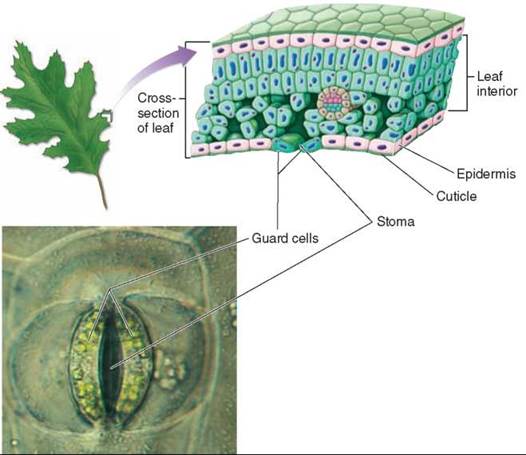
Figure 32.2. A stoma.
A stoma is a passage through the cuticle covering the epidermis of a leaf (x400). Water and oxygen pass out through the stoma, and carbon dioxide enters by the same portal. The cells flanking the stoma are called guard cells, and they control the opening and closing of the stoma.
Reproducing on Land
To reproduce sexually on land, it is necessary to pass gametes from one individual to another, which is a challenge because plants cannot move about. In the first plants, the eggs were surrounded by a jacket of cells, and a film of water was required for the sperm to swim to the egg and fertilize it. In later plants, pollen evolved, providing a means of transferring gametes without drying out. The pollen grain is protected from drying and allows plants to transfer gametes by wind or insects.
Changing the Life Cycle Among many algae, haploid cells occupy the major portion of the life cycle (see section 17.2). The zygote formed by the fusion of gametes is the only diploid cell, and it immediately undergoes meiosis to form haploid cells again. In early plants, by contrast, meiosis was delayed and the cells of the zygote divided to produce a multicellular diploid structure. Thus for a significant portion of the life cycle, the cells were diploid. This change resulted in an alternation of generations, in which a diploid generation alternates with a haploid one. Figure 32.3 shows a life cycle that exhibits an alternation of generations. Botanists call the haploid generation (the yellow boxed area) the gametophyte because it forms haploid gametes by mitosis 1. The diploid generation (the blue boxed area) is called the sporophyte because it forms haploid spores by meiosis 4.
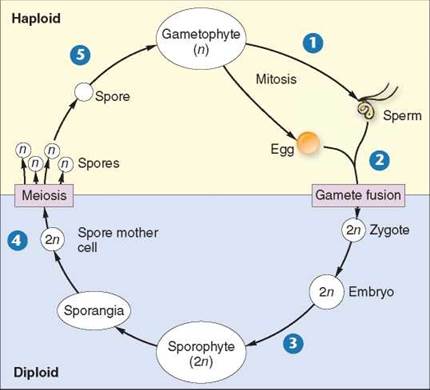
Figure 32.3. Generalized plant life cycle.
In a plant life cycle, a diploid generation alternates with a haploid one. Gametophytes, which are haploid (n), alternate with sporophytes, which are diploid (2n). 1 Gametophytes give rise by mitosis to sperm and eggs. 2 The sperm and egg ultimately come together to produce the first diploid cell of the sporophyte generation, the zygote. 3 The zygote undergoes cell division, ultimately forming the sporophyte. 4 Meiosis takes place within the sporangia, the spore-producing organs of the sporophyte, resulting in the production of the spores, which are haploid and are the first cells 5 of gametophyte generations.
When you look at primitive plants such as liverworts and mosses, you see mostly gametophyte tissue, the green leafy structures in the photo below—the sporophytes are smaller brown structures (not visible in the photo) attached to or enclosed within the tissues of the larger gametophyte.
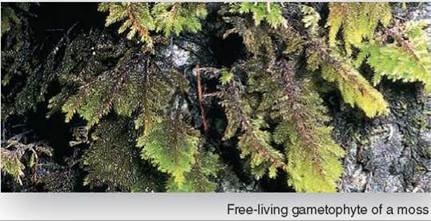
When you look at plants that evolved later, such as a pine tree, you see mostly sporophyte tissue. The gametophytes of these plants are always much smaller than the sporophytes and are often enclosed within sporophyte tissues. The photo below shows the male gametophyte (pollen grains) of a pine tree. They are not photosynthetic cells and are dependent upon the sporophyte tissue in which they are usually enclosed.
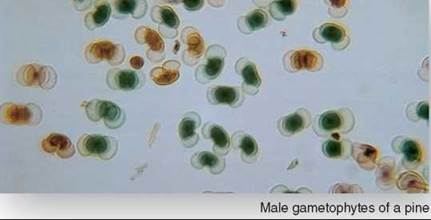
Key Learning Outcome 32.1. Plants are multicellular terrestrial photosynthesizers that evolved from green algae. Plants adapted to life on land by developing ways to absorb minerals in partnership with fungi, to conserve water with watertight coverings, and to reproduce on land.